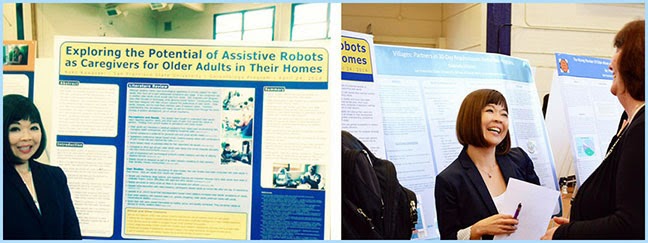I learned so much from this process and here are some interesting findings:
- Older adults are open to the idea of robots performing practical tasks such as managing information, manipulating objects, and assisting with household chores. Most prefer human aid for personal care needs (Smarr et al., 2013).
- Many expressed preferences for small, creative looking robots with combinations of human-like and machine-like traits. Humanoid robots were the least favored (Wu, Fassert, & Rigaud, 2012).
- For older adults, robots must fit seamlessly into living environments because home is a central, interconnected hub where people, products, and activities come together (Forlizzi, diSalvo, & Gemperle, 2004).
- Very few studies have considered socio-demographic variables on studies of robot acceptance and usage (Flandorfer, 2012).
 |
| Presenting my poster at a graduate studies showcase. (Photo on right: by D. Houlton) |
Presently, there are ethical concerns, cost of robots, and lack of availability. These are all important issues to consider. Furthermore, there is a general lack of user studies with older adults. I believe that robots have potential to provide assistance, but I also believe that there are so many areas that need to be addressed in order to move forward. On a positive note, there are many new technological products being created for older adults to live safely and independently in their homes.
Thank you for visiting my blog. If you have questions or comments, I would be interested in hearing from you. Less than one month until graduation! Woohoo!!!
